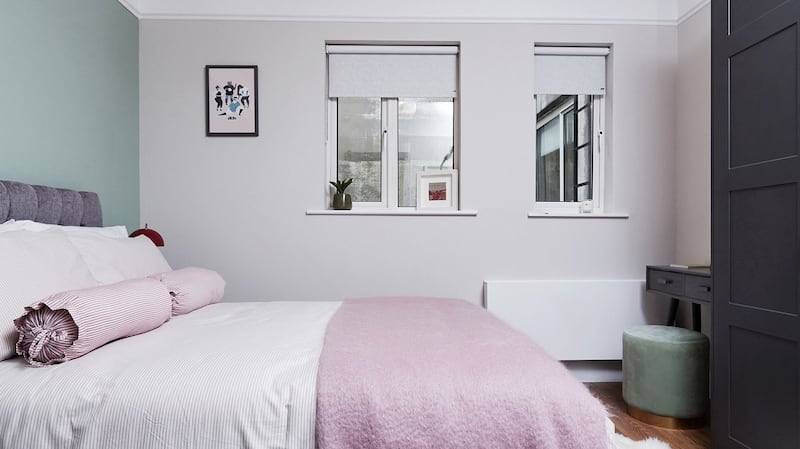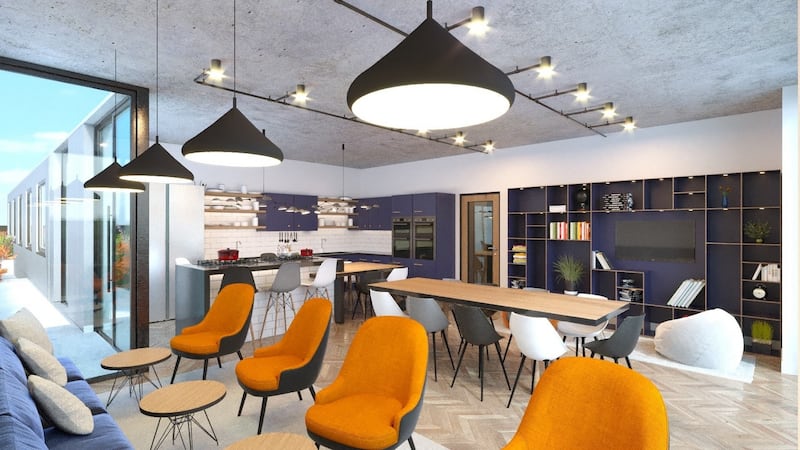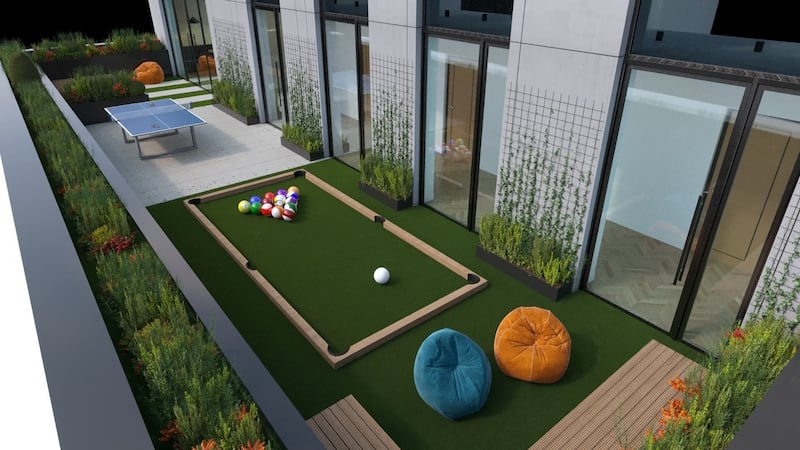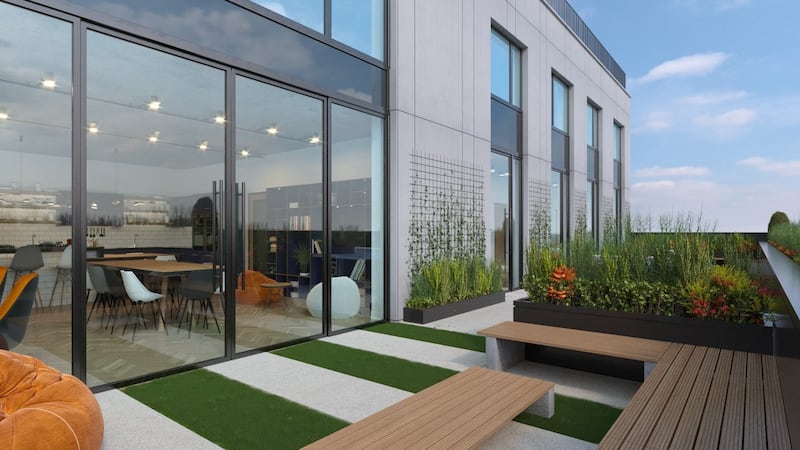If there was a single sight to encapsulate the dramatic changes to the fabric of the capital city over the past two decades, I suspect I’m looking at it.
I’m standing in what used to be Frawley’s department store on Thomas Street, watching two young men play an energetic game of table tennis in a space that could be a breakout zone in a tech company, or maybe the lobby area of a mid-price hotel.
Next door, two women are hard at work on their laptops in the study. There’s also a gym overlooking the courtyard and a roof terrace with spectacular views over the city’s rooftops as far as the Dublin mountains. Bedrooms are small but functional, with a small double bed and an ensuite bathroom.

This is currently the closest thing Ireland currently has to large-scale co-living – although it won't remain so for long. Called Highlight Thomas Street, this development is one of a number of student housing set-ups in the capital, and it does seem like an attractive, if pricey, solution to the student accommodation crisis.
The rooms in the Thomas Street building start at €215 per week for 10-12sq m bedrooms with a shared bathroom, and go up to €299, for what’s called the “Platinum Plus Ensuite”, for rooms of up to 28sq m.
Every kitchen/lounge area is shared by eight residents. The one Zoie, one of Highlight’s staff, shows me has been recently cleaned, so there are no greasy surfaces or pots scarred with the remains of too many spaghetti dinners.
She is surprised that’s what I was expecting. “We do have cleaners,” she says.
If Housing Minister Eoghan Murphy’s enthusiasm for the idea of co-living has anything to do with it, more adult professionals could eventually be sharing these kind of spaces.

At a Dublin housing conference last week, he said co-living offered an “exciting” choice to young workers. “This is a generation that has a different approach to things; they will sacrifice certain things for others, as we all did when we were younger.”
His comments, as has been widely reported, did not go down well. The Sinn Féin leader Mary Lou McDonald described one proposed co-living development in Dún Laoghaire "glamourised tenement living". Days later, at the Dublin election count centre in the RDS, protestors chanted that the Minister could "stick your co-living up your arse."
Mike Flannery, chief executive of Bartra, which was founded by Richard Barrett and is behind the Dún Laoghaire site, is frustrated by the focus on the fold-out beds and the 42 people sharing a kitchen. "What this is about is about choice. It's not about solving the housing crisis in one fell swoop," he says.
I tell him I wouldn’t choose to live like that. But it’s not designed for people like me, he counters. The target market is “people of 20 to 34 who would choose this over a similarly priced one-bedroom apartment”, because they don’t want to live alone.
At €1,300 a month including all bills, he believes it is more affordable than a one-bedroom flat. “I think it’s a very attractive piece of the accommodation puzzle for a certain cohort of people.”
He dismisses the notion “that people are going to end up renting this who are one step above homelessness. The housing solution for those people is social housing, which the government has a duty to provide. This is for young employed people.”

But do young employed people really want a fold-out bed and a kitchen they have to share with 41 others? “There is the option to fold up your bed, but you don’t have to. The room functions perfectly well with the bed pulled down.” Rooms are 16.5sq m.
What about the kitchen space shared between 42 people? “In Dún Laoghaire, every floor has two communal areas – there’s a dining and cooking area, and the other is a lounge relaxation area. There are 40 rooms per floor, but there isn’t [just] a single kitchen [in the traditional sense]. There’s a single large kitchen area, with multiple hobs, sinks, food preparation areas. So five or six people could be cooking at one time.”
The idea behind 40 rooms per floor was to optimise opportunities for social interaction, Flannery adds. “From our research, six to eight people sharing a living space is not enough.” To ensure there are people around at all times and to allow for that community buzz that’s central to co-living, you need to create communal spaces around larger groups, he says.
Maria, a Dublin-based professional now in her mid-20s, spent six months living in a large co-living development in the French city of La Roche-Sur-Yon when she was 20. The ratio of residents to kitchen was twice that proposed for Dún Laoghaire.

“There were about 80 people sharing a single small kitchen,” which was “bonkers” and, for a woman on her own in a predominantly male environment, “intimidating”. “I would send my boyfriend down to get a yoghurt out of the fridge, because I hated going in there.”
But overall, co-living was a positive experience, offering a convenient and affordable place to live, and the chance to make friends. “It’s a good layover type situation for foreign students and young working people. There were people there for two years, but for most of us, it was just a few months.”
One crucial difference was the affordability factor. She paid about €300 a month for her room in the scheme. If a similar option existed in Dublin, she’d consider it – but not at €1,300 a month.
The idea that Eoghan Murphy was perhaps trying to capture – that, in the right circumstances, people will sacrifice private space for more shared space, if it means better quality of life, greater affordability and a sense of community – is one that has been proven internationally.
The trick is getting the right balance between "the three Cs" – cost, community and convenience, says the founder and CEO of node, Anil Khera. Node has co-living spaces throughout the US, in Toronto, London, Manchester, and in Fitzwilliam Square in Dublin, where rooms in a three bedroom apartment are €1,325 a month. "The 'C' that Ireland hasn't quite figured out is what's the right cost and what's the right size."
The proposed rent of €1,300 for the Dún Laoghaire scheme “sounds kind of crazy,” says Khera. “What we’ve done is made a very expensive neighbourhood, Fitzwilliam Square, affordable to someone making €45,000 a year and up. I imagine if we went to some of these other neighbourhoods, we would definitely be bringing the price down significantly.”
The other issue is size. Says Khera: “One of the problems that’s happening right now with Bartra scheme and other developments, it’s a little bit too much like, ‘Hey, take the student living concept, make 42 people share a kitchen and give them 16sq m bedrooms’. The balance is skewed a little bit too much to the micro-living level…Where do you keep your milk in a kitchen with 42 other people?”
Khera – who is exploring other opportunities in Dublin and says “as we grow, we might look at Cork”– believes co-living model should involve 25 to 35sq m private apartments, and around six to eight people sharing a kitchen.
“The part of co-living that’s controversial is super-microsizing the private space. We need to have a policy that encourages slightly larger developments, so that not every one is stripped back to the bare minimum just to make numbers on a spreadsheet look more attractive.”
Architect Tom O’Donnell of Self Organised Architecture (SOA) points out that corporate style co-living isn’t the only solution that allows people to live together in a community setting. He supports “bottom-up led co-housing”, which is “co-operative or collaboratively-developed housing that’s organised by people themselves” with quality of life as one of its key aims.
There are at least 10 schemes at various stages of discussions in Ireland, though none at construction stage yet. SOA is hosting a conference on co-housing in Dublin later this month.

But are Irish people ready to adopt a more fluid attitude to what constitutes public and private space? "Does it require a culture shift? Yes," says O'Donnell. "The first thing Irish people say is that co-housing will never work here." But once you explain it, and point to successful collaborative models in Europe, people are more receptive.
In the right circumstances, living with other adults can be a positive experience, says Ronan Farrelly, who works in finance and spent all of his late 20s and 30s living in more organic co-living type arrangements in London. Sharing a large three bedroom apartment with strangers was a choice he made because it allowed him to live in a location he couldn't otherwise afford. The social aspect of it was also appealing.
“I think the reason Eoghan Murphy’s comments went down so badly is that if you felt you had no other choice, you wouldn’t feel that positive about it. But it enabled me to live in a certain place where I couldn’t afford to live alone.”
Since he has returned to Dublin, however, he has noticed a less positive attitude to groups of adults living together.
“In London, where everyone does it, it’s completely normal. But I wonder if I was doing it in Dublin, would I feel a bit like a failure?”

















